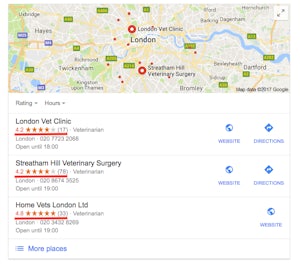Gone are the days when telephone books and word-of-mouth was enough to lift your business…
- Are you looking to grow your veterinary practice?
- Have you opened another practice in a different city and want to get enquiries through?
- Have you just launched a new website but getting little traffic?
- Are the enquiries you’re getting irrelevant and not high-quality?
One of the easiest ways to get new enquiries and clients to your veterinary practice or surgery is by creating and executing an SEO (search engine optimisation) strategy. SEO is the art of getting your business in that desired position number one (below the paid ads) so that the enquiries and clients can come flooding in.
The graph below is taken from Google Trends and shows a clear increase in searches over the past 11 years for the term ‘vets’ alone.

I have chosen seven tips to follow so that you can improve your online presence and use SEO to grow your business online.
1/ Learn the digital and analytics basics
Learning the Google analytics and digital basics is also straightforward thanks to so many resources made available by Google now. A great starting point is to work through Google’s Digital Garage.
Additionally, there are so many guides and resources out there that are designed to help give you guidance to grow your business. One of the most important ways to improve your organic performance and rankings is too read some industry-specific guides. Some of the best resources and guides that we would recommend taking a look at are:
- https://moz.com/beginners-guide-to-seo
A beginner’s guide to all things SEO split into 10 chapters - https://www.branded3.com/blog/the-technical-seo-audit-complete-guide/
Quite an in-depth blog from Branded3 about technical SEO but definitely worth a read for those interested in improving the technical performance of your site - https://blog.hubspot.com/blog/tabid/6307/bid/6080/40-essential-seo-terms-marketers-should-know-glossary.aspx
There is a lot of industry ‘jargon’ out there and SEOs are known to love to talk about SEO.. so avoid confusion over terms that are commonly used with Hubspots 40 Essential SEO Terms Marketers Should Know Glossary - Reading Impression’s blog, and similar blogs, is also a great place to start!

2/ Get to know local SEO
There are a lot of different areas of SEO and depending on your business goals and the industry that you are in, an SEO strategy would be built around this. For small businesses that are looking to attract customers from a specific area, i.e. hairdressers, doctors, restaurants, vets, plumbers, local SEO is crucial!
Greg Gifford did a great talk at Brighton SEO in April 2017 giving lots of tips on how to murder your competitors with local SEO. This includes more advanced local SEO techniques such as citation building and having a review platform that you can incorporate into the Search Results.
The image below shows the ‘map pack’ which you should make sure your business has. All you need to do is register your business on Google My Business and then Google will send you a postcard with a code. After filling in all your relevant contact and company information, and ensuring that it is the same on your website, you should start appearing in the map pack. If you have more than one location you will need to do this for each business location, ensuring that each profile has unique photos to that particular location.
Map pack in SERPs for ‘vets London’

3/ Know your keywords
There are now over 3.5 billion searches a day! Use Google’s Keyword Planner to conduct keyword research and find out what keywords your site should be ranking for. In order to beat the competition and generate new business it is crucial that you target a range of keywords. If the information isn’t on your site and isn’t targeting keywords then how will the user know what you offer?
It is important to have a range of landing pages (a landing page is a web page that is the entrance to your website with one focus) targeting a broad range of keywords. Depending on what Google believes the user’s intent is behind the search, Google will rank the most relevant pages with the most relevant information in the top positions.
Therefore if you are trying to target specific types of animals or pets then you will need to look at different landing pages for each pet. From this, conducting keyword research and ensuring that each landing page is focused on certain keywords will allow you to rank for a wide range of keywords. Not only that, but by ranking deeper and more specific pages it is more likely that the content is relevant to the search query and will be more likely to turn into a conversion.

Initial keyword research and targeting
Vets for cats – 390
Vets for dogs – 210
Vets for hedgehogs – 20
Vets for snakes – 20
Vets Nottingham – 260
Vets London – 260
This can also be used for different services and facilities that you have at your vets. For example, there may be search volume around ’24/7 vets’ so if you are a 24 hour veterinary practice then a lot of your traffic may come from ’24/7′ terms and there could be some great opportunities to claw up the search results!
4/ Understand conversions and conversion tracking
A conversion is when a user makes a specific action on your website. An example would be a user filling in an enquiry form or calling your telephone number. Some conversions are difficult to track, however, there are tools that you can implement which will allow you to see as much information about who is converting, where they are and what the quality of the conversion is.
This is where conversion tracking comes into play…
Once you are ranking in Google – and maybe you have lots of different landing pages ranking because you’ve implemented a solid keyword targeting strategy – it is crucial that you have a good understanding of where your conversions are coming from. This will help you to develop
There are a lots of plugins and strategies that you can use and take to help you track your conversions better. Approximately 25% of all websites are now use WordPress.
5/ Use imagery and videos
Having lifestyle imagery and images of your office on your website will put you at a big advantage over the competition. There are some industries where it may be difficult to find engaging images relevant to different landing pages to relate to your business and also to evoke emotion in the user.
However, for a vet practice and any other animal related businesses this is not a problem at all!
Make sure that you also include photos of your practice and facilities on your site too. Lifestyle photography can be really powerful on websites so try and avoid generic images and stock photography and entice the user in with your facilities.
‘Meet the team‘ pages are often useful on websites, particularly nowadays as a lot of communication is done over the phone or email in the initial stages. People still like to put a name to a face so ensuring that your website feels personal and that your company and employees are represented on the site will have a positive impact on user engagement and hopefully your conversion rate too!

6/ Keep an eye on the competition
Being up-to-date about what competition you have is a really important part of any business and it is just as important when improving your online presence. A ‘competitor analysis‘ is a key part of any digital marketing strategy. A competitor analysis can include some or all of the following:
- Analysing the keywords that your competitors are ranking for. You can use third party metrics for this such as SEMrush or Ahrefs.
- Analysing the backlinks of your competitors to see where they are getting coverage and features. You can also use SEMrush and Ahrefs to do this also.
- Analysing the functionality of competitors websites. Do they have features onpage that you don’t? Are there elements of their websites that you are missing and should have on yours?
- Analysing their content generally. Do they have a blog? Or a news section? Do they have guides explaining how to know if your dog is ill?
You can then use information gathered in your competitor analysis to form part of your own SEO strategy. Of course, original ideas are always a must in SEO too, but if one of your competitors is ranking above you for all your core keywords the chances are that they are doing something that should be!
7/ Get links with content
Content is a great way to drive traffic to your site, as long as you’re writing about things that potential clients would be interested in (i.e. make it relevant). There are some great examples of content out there that you can take inspiration from, and great content = naturally earned links to your site.
Links are important to improve the organic performance of your site so it is important that you have a good off-page strategy to help you gain coverage in online publications and build links to your website. Paddy Moogan did a great talk at Brighton SEO in April explaining how link building can be for everyone – you don’t need massive content marketing pieces and a big budget to gain links to your site.
Types of content:
- Videos – integrated on your site not on a YouTube channel
- Infographics – these are great for user experience and can be incorporate in a paid social media strategy too to gain ultimate engagement and build natural links to your site!
- Guides – these can be in the form of infographics, videos or simple web pages covering a topic or area that your audience would be interested in i.e. how to keep your dog warm in the Winter and cool in the Summer
- Quizzes – quizzes are a great way to engage the user and as a vet’s target audience is pet owners you can really use this to your advantage – people really love their pets and treat them like part of the family! Think of ideas such as ‘what type of dog owner are you?’ or ‘how needy is your dog?’
I hope you found this whistle-stop tour of how vets can improve their SEO performance useful. If you would like any more information on the areas covered in this article, please call 01158 242 212 to speak to a member of the team, or email hello@impression.co.uk.



